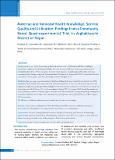Please use this identifier to cite or link to this item:
https://hdl.handle.net/20.500.14356/1760| Title: | Maternal and Neonatal Health Knowledge, Service Quality and Utilization: Findings from a Community Based Quasi-experimental Trial in Arghakhanchi District of Nepal |
| Authors: | Shrestha, J R Manandhar, D S Manandhar, S R Adhikari, D Rai, C Rana, H Poudel, M Pradhan, A |
| Citation: | ShresthaJ. R., ManandharD. S., ManandharS. R., AdhikariD., RaiC., RanaH., PoudelM., & PradhanA. (2015). Maternal and Neonatal Health Knowledge, Service Quality and Utilization: Findings from a Community Based Quasi-experimental Trial in Arghakhanchi District of Nepal. Journal of Nepal Health Research Council. https://doi.org/10.33314/jnhrc.v0i0.599 |
| Issue Date: | 2015 |
| Publisher: | Nepal Health Research Council |
| Article Type: | Original Article |
| Keywords: | CB-NCP Facility strengthening HFOMC MNC QI PMNH Nepal |
| Series/Report no.: | Jan-April, 2015;599 |
| Abstract: | Abstract Background: As part of the Partnership for Maternal and Newborn Health Project (PMNH), HealthRight International collaborated with Mother and Infant Research Activities (MIRA) to conduct operations research in Arghakhanchi district of Nepal to explore the intervention impact of strengthening health facility, improving community facility linkages along with Community Based Newborn Care Program (CB-NCP) on Maternal Neonatal Care (MNC) service quality, utilization, knowledge and care seeking behavior. Methods: This was a quasi-experimental study. Siddahara, Pokharathok, Subarnakhal,Narpani Health Posts (HPs) and Thada Primary Health Care Center(PHCC)in Electoral Constituency-2 were selected as intervention sites and Arghatosh, ,Argha, Khana, Hansapur HPs and Balkot PHCC in Electoral Constituency-1 were chosen as controls. The intervention started in February 2011 and was evaluated in August 2013. To compare MNC knowledge and practice in the community, mothers of children aged 0-23 months were selected from the corresponding Village Development Committees(VDCs) by a two stage cluster sampling design during both baseline (July 2010) and endline (August, 2013) assessments. The difference in difference analysis was used to understand the intervention impact. Results: Local resource mobilization for MNC, knowledge about MNC and service utilization increased in intervention sites. Though there were improvements, many effects were not significant. Conclusions: Extensive trainings followed by reviews and quality monitoring visits increased the knowledge, improved skills and fostered motivation of health facility workers for better MNC service delivery. MNC indicators showed an upsurge in numbers due to the synergistic effects of many interventions.  Keywords: CB-NCP, facility strengthening, HFOMC, MNC QI, PMNH, Nepal |
| Description: | Original Article |
| URI: | http://103.69.126.140:8080/handle/20.500.14356/1760 |
| ISSN: | Print ISSN: 1727-5482; Online ISSN: 1999-6217 |
| Appears in Collections: | Vol. 13 No. 1 Issue 29 January - April 2015 |
Files in This Item:
| File | Description | Size | Format | |
|---|---|---|---|---|
| 78_83.pdf | Fulltext Download | 210.84 kB | Adobe PDF |  View/Open |
Items in DSpace are protected by copyright, with all rights reserved, unless otherwise indicated.
